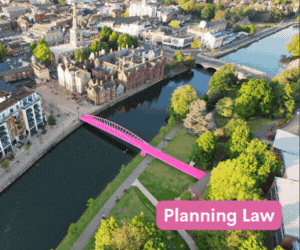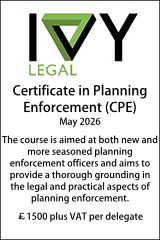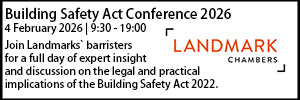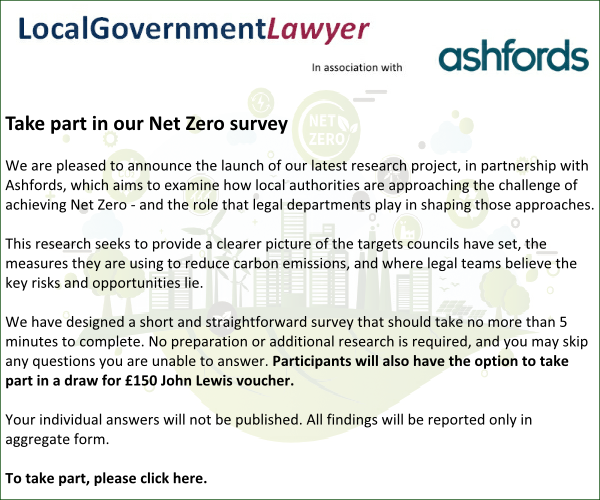Section 106s and yet more reflection
- Details
John Pugh-Smith considers not only the “takeaways” from a recent case on publication of draft section 106 agreements, but also reflects on how the litigation could have been avoided or truncated had “ADR” (Alternative Dispute Resolution) been deployed.
While the case law on Section 106 issues should now be settled, the recent decision by the Court of Appeal in R (Greenfields (IOW) Ltd) v Isle of Wight Council & Westridge Village Limited [2025] EWCA Civ 488 reminds that the purpose of publication of the draft on the local planning authority’s website is to enable members of the public to know the terms of a proposed or agreed planning obligation, and to enable them to comment on it if they choose to do so.
The Case
The Council had first resolved to grant Westridge permission at a meeting of its Planning Committee in July 2021 for a development comprising 473 homes and related infrastructure at Ryde, Isle of Wight. The proposed development was controversial. One of the points of controversy concerned the impact of the proposed development, and other developments, on the highways network and how the costs of any works mitigating that impact would be funded. The Section 106 negotiations also became protracted. So, the application was put back before back to a Planning Committee meeting on 25 April 2023, whereupon it was resolved again that permission should be granted. The Section 106 was then agreed and planning permission finally issued on 4 August 2023.
However, the Council had failed to place either the draft or the final Section 106 on its planning register. The company, Greenfields (IOW) Limited, had been set up by local residents and objectors to initiate judicial review proceedings challenging the decision to grant planning permission. Before HH Judge Jarman KC (sitting in the High Court) the Council’s resolution and the decision notice were upheld. However, Lewison LJ granted permission to appeal on four grounds of which the first is relevant to the successful outcome of the challenge and this article, namely, breach of Article 40(3) of the Town and Country Planning (Development Management Procedure) (England) Order 2015 (“DMPO”).
On the legal merits, Greenfields’ appeal succeeded on its first ground relating to the failure of the Council to publish the Section 106 agreement on its planning register before the decision notice had been issued. The Court of Appeal found that, had it had sight of the Section 106 Greenfields would have been highly likely to make representations to the Council on its contents, in particular, because its shareholders had been concerned with the adequacy of the financial sum to be secured to provide for certain highways works. Further, Greenfields had been unable to establish from any information in the public domain what that sum would be. Indeed, the sum which was eventually secured had been substantially lower than Westridge’s estimate of the cost of the relevant works.
Having found for Greenfields, the Court allowed time for the parties to make representations as to the appropriate remedy. This led to a subsequent final order confirming that the August 2023 permission stood quashed but that the Council's April 2023 resolution to grant permission remained valid and lawful.
Interestingly, on the issue of the litigation costs, the sealed Court Order dated 20th April 2025 [1] included the return of the sum of £20,000 paid by the Appellant into court and the First Respondent (the Council) being liable for 75 per cent of the Appellant’s costs on appeal and below, subject to detailed assessment if not agreed, such sum not to exceed £70,000 (by reason the £35k cap by virtue of CPR 44.26 (Greenfields’ Aarhus protection) and £35k pursuant to Lewison LJ’s order granting permission to appeal) with the sum of £50,000 being payable on account of costs within 14 days. The stated reasons also explain that the figure of 75 per cent reflected the fact that the Appellant had not succeed on all its grounds nor did the First Respondent on the issues raised in the Respondent’s notice.
Comment
Following the publication of the judgment, handed down on 16th April 2025, there was considerable “industry chatter” about this important procedural reminder and the legal and procedural consequences for local authority officers and advisers.
The significance of the case is that it clarifies the proper approach to breaches of procedural obligations under the DMPO and other similar legislative provisions. In this regard, Lewis LJ (giving the lead judgment) accepted Greenfields’ submission that the lawfulness of compliance with DMPO requirements is to be approached applying the decisions in R v Soneji [2006] 1 AC 340 and A1 Properties Ltd v Tudor Studios RTM Co Ltd [2024] UKSC 27 i.e. by asking what Parliament intended the consequences of the breach in question to be, having regard to (1) the extent to which there had been substantial compliance with the purposes of the legislative provision, and (2) the extent of any prejudice.
Applying those principles, Lewis LJ found that the purpose of publishing the actual draft Section 106, and not simply Heads of Terms, is to enable members of the public to know the terms of a proposed or agreed planning obligation, and, to enable them to comment on it if they choose to do so.
In the particular context, the absence of publication of the draft Section 106 was particularly prejudicial; for the objecting local residents only had Heads of Terms, which had been set out in the report to the Planning Committee. The amount of the highways financial contribution was not provided. Indeed, it remained unknown to Greenfields until after the issue of the actual planning permission decision notice. Therefore, the Court agreed that the objectors had been manifestly deprived of the opportunity to make representations as to the contribution’s amount.
Reflecting on the foregoing leads to the following reminders:
- Local planning authorities have to comply fully with the DMPO’s publicity requirements and not assume that a lesser standard of “need to know” should be applied to the general public. Published Heads of Terms only reflect, at best, agreement to agree.
- Developers and local authorities should neither under-estimate (nor over-promise) the need to swiftly secure the required Section 106 obligations when seeking to get permissions over the line, particularly when faced with local residents’ objections; for protracted time spent in viability negotiations may not always lead to better outcomes. Rather, there should be the ability within the wording of the Section 106 to re-visit such matters, with a more nuanced approach to dispute resolution than a default referral to a single independent expert.
- The ability to modify a Section 106 agreement, even after five years, is limited and rarely succeeds save on a consensual basis. Despite the ability to apply for modification or discharge after five years under Section 106A such cases as R (Millgate Developments v Wokingham BC [2011] EWCA Civ 1062 and R (Mansfield DC) v SSHCLG [2018] EWHC 1794 (Admin) demonstrate that the Courts will continue to uphold local authorities’ demands that the developer should be held to the planning obligations it contracted to discharge even if circumstances have subsequently changed.
- Furthermore, completed Section 106s, whether bi-lateral or unilateral, are formal deeds so must be interpreted on that basis. [3] Therefore, particular care must be given to their drafting, the salutary tales to the contrary being exampled by the two other recent challenges Norfolk Homes Limited v North Norfolk District Council & Norfolk County Council [2020] EWHC 2265 (QB) and Redrow Homes Ltd v Secretary of State for Levelling Up, Housing and Communities & New Forest District Council [2023] EWHC 879 (Admin). Both arose out of subsequent Section 73 amended consents and a lack of appreciation of the “carry over” effects from the original Section 106 agreements, in the former by the local planning authority (who managed to lose the affordable housing element) and the latter by the housebuilder (who was shackled to an unbuildable footbridge over a railway). Unlike the Norfolk Homes case (where the original planning permission had not been implemented and the obligations in the Section 106 had therefore not yet arisen) in Redrow not merely had the operative permission been implemented but it had, in all material respects, been completed.
Concluding remarks
It is, perhaps, a sad reflection of the state of the planning system that High Court challenges have to be taken where pragmatism and common-sense might have led to a better and earlier outcome. Indeed, because High Court challenges can only succeed if a genuine error of law is found, and, one sufficient to justify quashing the decision, the final outcome may not always be what the claimant had hoped at the outset, as in the instant circumstances. Therefore, I wonder what might have been the sooner outcome if the judicial review proceedings had been stayed for formal mediation (as now encouraged by the CPR amendments since last October 2024) and/or neutrally chaired discussion between the principal parties had occurred back in 2023.
Looking ahead, if real housing growth is to be delivered in our current economic climate then both the current Government needs to “dial down” the overly simplistic rhetoric of “builders v blockers”, and local planning authorities and developers need to be encouraged to embrace less adversarial processes. Even now, through its Planning & Infrastructure Bill, the Government could adopt the approach taken by the Scottish Government in its reforming Planning (Scotland) Act 2019 and include a general provision to promote and use mediation.
Even without such statutory recognition, such facilitation techniques are already available, and can still be swiftly deployed. So, all round, lessons can and should be learned from and through the Greenfields case as to how to “do better”.
John Pugh-Smith FCIArb of 39 Essex Chambers is a recognised specialist in the field of planning law with related disciplines acting for both the private and public sectors. He is also an experienced mediator, arbitrator and dispute ‘neutral’ dealing with section 106 obligations and their outworkings along with other development related disputes.
[1] Greenfields (IOW) Ltd, R (On the Application Of) v Isle of Wight Council & Anor [2025] EWCA Civ 488
[2] With thanks to Greenfields’ counsel, Charles Streeten, for his Linked-in posting of the sealed Court Order.
[3] Arnold v Britton [2015] AC 1619; Wood v. Capita Insurance Services Limited [2017] 2 WLR 1095; R (Robert Hitchins Ltd) v Worcestershire County Council & Worcester City Council [2015] EWCA Civ 1060), as applied by Holgate J in Norfolk Homes Limited v North Norfolk District Council & Norfolk County Council [2020] EWHC 2265 (QB)
[4] https://www.legislation.gov.uk/asp/2019/13/section/40
Sponsored articles
Walker Morris supports Tower Hamlets Council in first known Remediation Contribution Order application issued by local authority
Unlocking legal talent
Lawyer (Planning and Regulatory)
Legal Director - Government and Public Sector
Contracts Lawyer
Locums
Poll







































